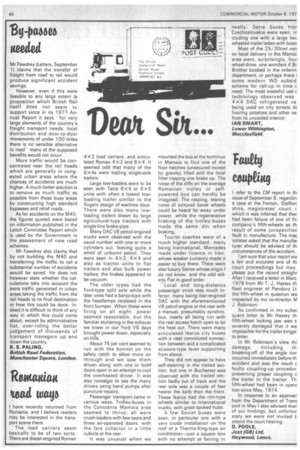Reigaitiffit 'toad =Jo
Page 50

If you've noticed an error in this article please click here to report it so we can fix it.
I have recently returned from Romania, and I believe readers may be interested in the transport scene there.
The load carriers seem basically to be of two sorts. There are diesel-engined Roman 4 X 2 load carriers, and articulated Roman 4 x 2 and 6 x 4. It seemed odd that many of the 6 X 4s were trailing single-axle trailers.
Large low-loaders were to be seen with Tatra 6 x 4 or 6x6 units with often a towed lowloading trailer similar to the Rogers design of wartime days. There were also many lowloading trailers drawn by large agricultural-type tractors with single-line brake-pipe.
Many DAC V8 petrol-engined trucks were observed with the usual number with one or more cylinders out, leaving quite a smell of unburnt petrol. They were seen in 4 x 2, 4X4 and also as tractor units to flat trailers and also bulk power trailers; the brakes appeared to be vacuum.
The older types had the Ford-type split axle while the later ones had a banjo-type with the headlamps recessed in the front bumper. When these were firing on all eight, power seemed reasonable, but .the familiar stuttering in the exhaust we knew in our Ford V8 days brought power down, especially on hills.
About 75 per cent seemed to run with the bonnet on the safety catch to allow more air through and we saw them driven along with one or both' doors open in an attempt to cool the overheated driver. It was also nostalgic to see the many drivers using hand pumps after puncture repairs.
Passenger transport came in various ways. Trolley-buses in the Constanta Mamaia area seemed to thrive; all were crush-loaders with few seats and three air-operated doors, with the fare collector in a little cubicle at the rear.
It was unusual when we


























































































































































